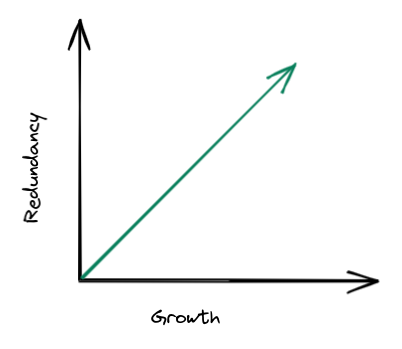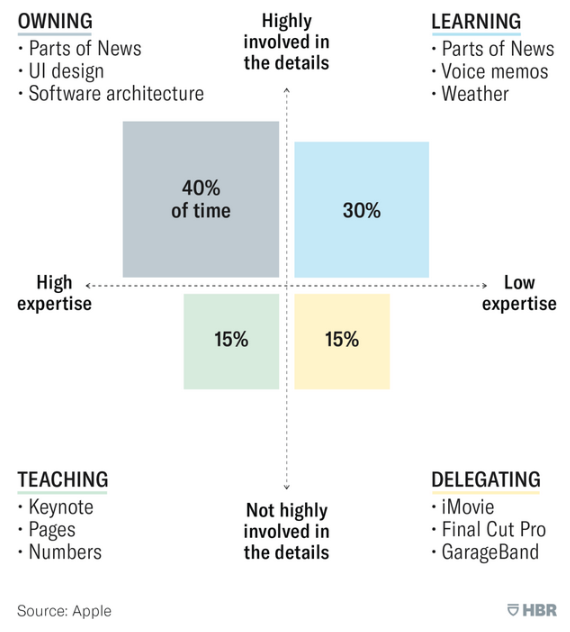To grow, make yourself redundant
Redundancy ∝ Grow

Making yourself redundant can unlock new career opportunities.
Are you confused? You are not alone. Many people fear that making themselves redundant will make them dispensable.
In today’s changing landscape, it’s more important than ever for professionals to be proactive about their own career growth. One effective strategy for achieving this is to make yourself redundant.
You can follow this five-step approach to achieve redundancy and growth
-
Delegate: Delegate tasks to free up time for strategic work.
Delegating your current tasks and responsibilities, you free up time and energy to invest in more strategic and higher-value activities. This improves your productivity and positions you as a valuable asset to your organization by demonstrating your willingness to take on new, challenging roles.
-
Build new skill: Expand your expertise by developing new skills that go beyond your current role.
Invest in your own development by taking courses or taking on new responsibilities that are outside your current role. This can help you develop new skills and demonstrate your value to the organization.
A study by the World Economic Forum found that professionals who build new skill and adapt to new technologies are more likely to be in demand in the job market. The study found that around 54% of all employees will need significant reskilling and upskilling to stay relevant in the job market.
-
Document yourself: Create clear documentation to make it easy for others to follow your processes.
Documenting your processes can help you identify areas where you can improve and streamline your work. It also makes it easier to delegate tasks to others and ensures that your work can continue in your absence. By making yourself redundant, you free up time to focus on higher-value activities and position yourself as a valuable asset to your organization.
-
Collaborate: Work with others to gain new perspectives and broaden your skill set.
Collaborating with others can also lead to new opportunities and help you build a network of contacts that can be valuable in the organization and throughout your career.
-
Seek feedback: Actively request feedback to identify areas for growth and improvement.
Ask your manager or coworkers for feedback on improve your performance. Use this feedback to identify areas where you can develop your skills and become more valuable to the organization.
Embracing these can lead to growth by allowing individuals to improve and develop new skills.
By seeking opportunities to learn and grow, individuals can position themselves as valuable assets to their organization and increase their chances of advancement. Additionally, learning and adapting to new technologies and industry trends can help individuals stay relevant in an ever-changing business landscape.
The discretionary leadership model presented in “How Apple Is Organized for Innovation” HBR article provides a perfect visual model that you can make use of to categorize your responsibilities by
- Owning: stuff you own currently or need your expertise in
- Learning: stuff you want to learn and grow your knowledge in
- Teaching: stuff you want to mentor and guide others
- Delegating: stuff you are delegating or want to delegate
to help you with the above-listed five-step approach.

Additionally, a report by Deloitte Insights studied the future of work and mentioned, “Individuals should set their sights on longer careers with multiple stages, each involving ongoing training and reskilling.” This further supports the idea that making yourself redundant in your current role can benefit career growth.
It also emphasizes that professionals with diverse skills and experience who are adapting to new technologies and who take on a more consultative role within their organizations are more likely to be in demand in the job market and considered for leadership positions.
As AI and other technologies continue to advance, it’s crucial for professionals to adapt to stay relevant in the job market. This will help them be less susceptible to being replaced by automation or outsourcing and increase their chances of success in the current and future job market.
In conclusion, making yourself redundant can seem counter-intuitive, but it can be a powerful career growth strategy. It allows you to focus on higher-value activities, increase your value to the organization, stay relevant in the job market, and position yourself as a thought leader and potential candidate for leadership roles. By identifying areas where you can make yourself redundant, you can take control of your own career growth and stay ahead of the curve in the fast-paced business world.